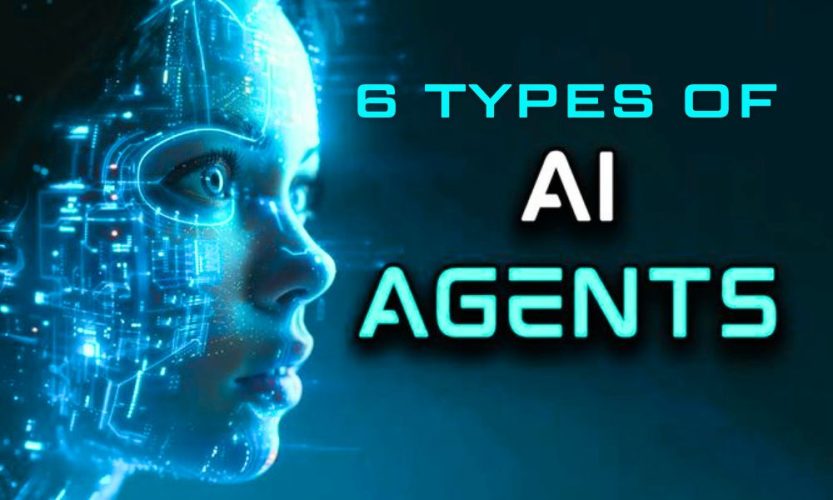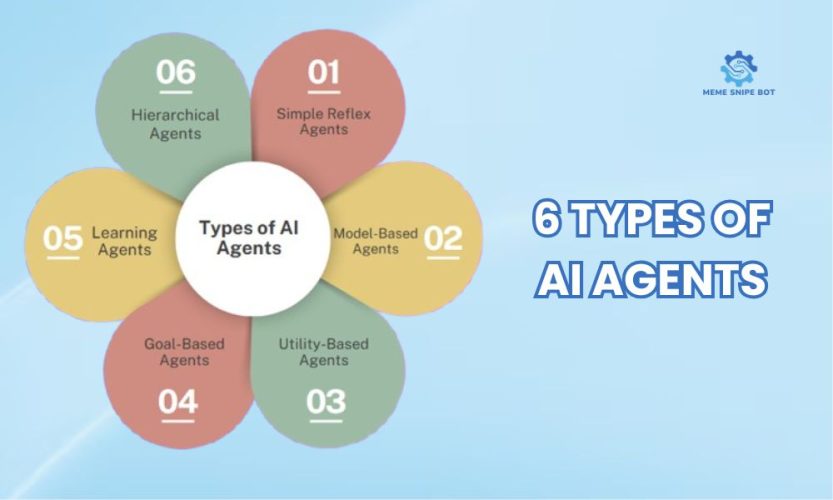6 types of ai agents provide a fundamental framework for understanding how artificial intelligence systems perceive their surroundings, interact, and make decisions. From basic reflexes to sophisticated learning abilities, each of these agent types is pivotal in the advancement of technology, unlocking a myriad of practical applications across various aspects of our lives.

Contents
What is an AI agent?
Before diving into the 6 types of ai agents, let’s first define what an AI agent is. Simply put, an AI agent is anything that can be viewed as perceiving its environment through sensors and acting upon that environment through actuators. The goal of an AI agent is to perform actions to achieve specific objectives or optimize a performance measure.
An AI agent is often described using the PEAS framework:
- P (Performance measure): The criteria for evaluating the agent’s success.
- E (Environment): The context in which the agent operates.
- A (Actuators): How the agent acts upon the environment.
- S (Sensors): How the agent perceives the environment.
Exploring the 6 types of ai agents
Based on their level of intelligence and capabilities, scientists have categorized AI agents into various types. Below are the most common and fundamental 6 types of ai agents:

Simple Reflex Agents
These are the most basic AI agents. They act only based on the current percept, ignoring the rest of the percept history. Their operation is based on condition-action rules: “if X happens, then do Y.”
Characteristics: No memory of the past, reacts instantaneously to current stimuli.
Example: An automated thermostat that turns on the heater when the room temperature drops below a certain threshold. A robotic vacuum cleaner that changes direction when it bumps into an obstacle.
Model-based Reflex Agents
These AI agents are more advanced than simple reflex agents because they maintain an internal state to keep track of the world around them. This internal state is a model of how the world works, based on percept history.
Characteristics: Capable of handling partially observable environments, uses a world model to make decisions.
Example: A self-driving car using cameras and sensors to build a model of the positions of other cars and obstacles, even if they are temporarily obscured.
Goal-based Agents
These AI agents not only act based on the current state but also have information about their goal. They choose actions that will lead them closer to that goal. This process often involves search and planning.
Characteristics: Acts with a clear purpose, capable of planning to achieve goals.
Example: A warehouse robot that needs to find and retrieve a specific package from a shelf. A GPS navigation system finding the shortest or fastest route to a destination.
Utility-based Agents
When there are multiple ways to achieve a goal, or when the goal is not clear-cut, utility-based agents—a sophisticated category within the 6 types of ai agents—will choose the action that yields the highest “happiness” or “utility.” Utility is a function that maps a state (or a sequence of states) to a real number, representing the degree of desirability.
Characteristics: Optimizes actions to achieve the best outcome according to a utility measure, capable of making decisions in complex situations with multiple trade-offs.
Example: A movie recommendation system selecting movies based on user preferences and ratings of different films to maximize satisfaction. An automated trading bot deciding to buy/sell stocks based on an analysis of potential profit and risk.
Learning Agents
This is the type of AI agent capable of self-improvement through experience. It includes a “learning element” for improvements, a “performance element” to select actions, a “critic” to evaluate actions, and a “problem generator” to suggest new exploratory actions. Among the 6 types of ai agents, learning agents are particularly powerful due to their adaptability.
Characteristics: Ability to adapt to changing environments, automatically improves over time.
Example: Spam filters that learn to identify spam emails based on user feedback. Voice recognition systems that improve their accuracy with each interaction.
Hierarchical Agents
In many complex tasks, breaking down the problem into layers or sub-modules is more effective. Hierarchical agents operate under this structure, with higher-level agents setting goals for lower-level agents. This layered approach allows for efficient management of complex tasks.
Characteristics: Solves complex problems by dividing them into sub-tasks, manages and coordinates between different levels.
Example: A complex robotic system might have a high-level agent planning overall movement, mid-level agents controlling specific limbs, and low-level agents managing individual joints.
The importance of understanding these AI agent types
The classification and thorough understanding of these agent architectures are not merely academic exercises. They provide a solid framework for developers and researchers when designing and building new AI systems.
Each type of AI agent has its own advantages, disadvantages, and suitability for specific problem types. The progression from simple reflex agents to complex learning agents also illustrates the evolutionary journey of artificial intelligence, increasingly approaching human-like thinking and problem-solving capabilities.
In summary, the 6 types of ai agents, ranging from simple to complex, are shaping how we interact with technology. Understanding them opens the door to exploring the limitless potential of artificial intelligence. Keep following Meme Snipe Bot for more insightful AI knowledge!
